- Home
- >
- Software Development
- >
- What is Software Development Life Cycle (SDLC)?
If a company wants to have digital transformation and expand its client base, it must invest in software development. It promotes firms to develop customized solutions to satisfy the needs of their customers. Businesses may acquire recognition and achieve new heights of success. This article will discuss what is Software Development, the significance of the software development process, and how you may speed up the development software.
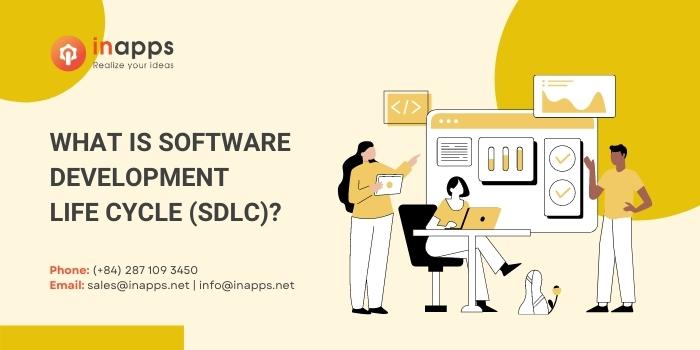
What is software development life cycle?
Key Summary
- Overview: The article by InApps Technology explains the Software Development Life Cycle (SDLC), a structured process for planning, developing, testing, deploying, and maintaining software, ensuring quality, efficiency, and alignment with business goals.
- What is SDLC?:
- Definition: SDLC is a systematic framework that guides software development through distinct phases, from ideation to maintenance, to deliver reliable, scalable, and cost-effective software.
- Purpose: Standardizes development processes, reduces risks, manages resources, and ensures stakeholder expectations are met.
- Key Characteristics:
- Iterative or linear, depending on the methodology (e.g., Waterfall, Agile).
- Involves cross-functional teams (developers, testers, project managers).
- Applicable to various software projects (e.g., web apps, mobile apps, enterprise systems).
- SDLC Phases:
- 1. Requirement Analysis:
- Description: Gather and document business and technical requirements from stakeholders.
- Activities: Interviews, surveys, feasibility studies, defining scope.
- Output: Software Requirement Specification (SRS) document.
- Example: Identifying features for an e-commerce app, like user login and payment processing.
- 2. Planning:
- Description: Define project scope, timelines, resources, and risks.
- Activities: Budget estimation, team allocation, tool selection, risk mitigation strategies.
- Output: Project plan and schedule.
- Example: Creating a Gantt chart for a six-month web app development project.
- 3. Design:
- Description: Create architectural and technical blueprints for the software.
- Activities: System design (high-level) and detailed design (e.g., UI/UX, database schemas, API endpoints).
- Output: Design documents, wireframes, prototypes.
- Example: Designing a microservices architecture for a cloud-based CRM system.
- 4. Development:
- Description: Write and compile software code based on design specifications.
- Activities: Coding, version control (e.g., Git), integration of frameworks (e.g., React, Django).
- Output: Functional software or modules.
- Example: Coding a user authentication module for a mobile app.
- 5. Implementation:
- Description: Test the software to ensure it meets requirements and is free of defects.
- Activities: Unit testing, system testing, testing, user acceptance testing (UAT).
- Tools: Selenium, JUnit, Postman.
- Output: Tested software ready for deployment.
- Example: Running automated tests to verify payment gateway integration.
- 6. Deployment:
- Description: Release the software to the production environment.
- Activities: CI/CD pipelines, data migration, user training.
- Tools: Jenkins, Docker, Kubernetes.
- Output: Deploying a web app to AWS for public access.
- Example: Rolling out a new e-commerce platform with zero downtime.
- 7. Testing and Maintenance:
- Description: Monitor and update the software to fix bugs, improve performance, and adapt to new requirements.
- Activities: Bug fixing, updates, performance optimization, user support.
- Output: Updated software versions, patches.
- Example: Releasing a version update to add multi-language support for an app.
- 1. Requirement Analysis:
- Common SDLC Methodologies:
- 1. Waterfall:
- Linear, sequential phases; ideal for projects with fixed requirements.
- Example: Developing a government compliance system.
- 2. Agile:
- Iterative, flexible, with sprints; suits dynamic projects.
- Example: Building a startup’s mobile app with frequent updates.
- 3. DevOps:
- Combines development and operations for continuous integration and delivery.
- Example: Deploying microservices with CI/CD pipelines.
- 4. Spiral:
- Risk-driven, iterative approach for complex projects.
- Example: Developing a high-security banking system.
- 5. V-Model:
- Testing aligned with each development phase; emphasizes verification and validation.
- Example: Creating medical software with strict quality requirements.
- 1. Waterfall:
- Benefits:
- Structure: Provides a clear roadmap for development, reducing chaos and delays.
- Quality: Ensures thorough testing and alignment with requirements.
- Cost Efficiency:
- Early issue detection reduces rework costs.
- Offshore development in Vietnam ($20–$50/hour via InApps Technology) saves 20–40% compared to U.S./EU rates ($80–$150/hour).
- Risk Management: Identifies and mitigates risks in planning and design phases.
- Scalability: Supports projects of varying sizes, from startups to enterprises.
- Example: A startup uses Agile SDLC to iteratively build a scalable SaaS platform.
- Challenges:
- Requirement Changes: Late changes can disrupt linear models like Waterfall.
- Resource Allocation: Poor planning may lead to understaffing or budget overruns.
- Complexity: Large projects require robust coordination across teams.
- Time Constraints: Tight deadlines may compromise testing or quality.
- Example: A rushed deployment skips UAT, leading to post-launch bugs.
- Security Considerations:
- Secure Coding: Follow OWASP guidelines to prevent vulnerabilities (e.g., SQL injection, XSS).
- Access Control: Implement RBAC during development and deployment.
- Encryption: Use TLS for data in transit and encryption at rest.
- Auditing: Log activities in all phases to ensure compliance (e.g., GDPR, HIPAA).
- Example: Conducting security reviews during the design phase to secure API endpoints.
- Use Cases:
- E-commerce: Developing online stores with secure payment systems.
- Healthcare: Building HIPAA-compliant patient management software.
- Fintech: Creating scalable banking apps with robust testing.
- Startups: Iteratively developing MVPs using Agile for rapid market entry.
- Enterprise: Deploying ERP systems with Waterfall for fixed requirements.
- InApps Technology’s Role:
- Offers expertise in SDLC implementation, from planning to maintenance, using Agile, DevOps, and other methodologies.
- Leverages Vietnam’s 200,000+ IT professionals, providing cost-effective rates ($20–$50/hour) for high-quality development.
- Supports Agile workflows with tools like Jira, Slack, and Zoom for transparent collaboration (GMT+7).
- Recommendations:
- Choose Agile or DevOps for flexible, iterative projects; use Waterfall for stable requirements.
- Invest in thorough requirement analysis to minimize scope creep.
- Integrate security practices early in the SDLC to reduce vulnerabilities.
- Partner with InApps Technology for expert SDLC-driven development, leveraging Vietnam’s skilled developers for cost-effective, high-quality software solutions.
What is Software Development?
Software development is creating standalone or individual software using a computer language. It entails creating a network of interconnected computer code that offers the functionality of the generated software.
Software development is an iterative logical process that creates computer-coded or programmed software to satisfy a specific commercial or personal objective, goal, or procedure. In most cases, software development is a planned undertaking that consists of several processes or stages that culminate in creating functional software.
What is Software Development Life Cycle?
In the 1960s, SDLC was known as the “systems development lifecycle“. According to Geoffrey Elliott’s book, Global Business Information Technology, huge organizations established the model to aid in the management of complex business systems that required a great deal of data processing and analysis.
The software development lifecycle (SDLC) is a framework used by development teams to build high-quality software in an organized and cost-effective manner. Both large and small software firms use the SDLC approach. These teams use a variety of development methodologies, including agile, lean, and waterfall.
The software development lifecycle provides businesses with a systematic, step-by-step strategy to build practical software from gathering the first requirements for a new product. We’ll show you how to use SDLC by keeping a mature product on the market.
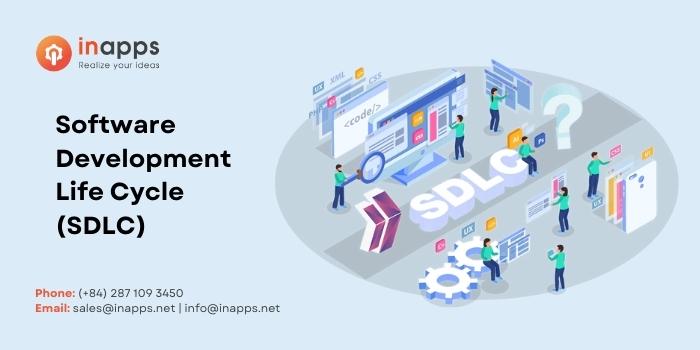
Software development phases
Advantages of the Software Development Lifecycle
The SDLC paradigm provides several benefits to software development teams, including:
- Bringing the cost of software development down.
- Improving the quality of the software delivered by the company.
- Reducing development time by avoiding after-the-fact corrections.
- Assisting developers in better understanding what and why they are developing.
- Assuring that all stakeholders have an opportunity to contribute early in the development process.
- Giving everyone on the cross-functional team a grasp of the project’s expenses and resources.
Because the software development lifecycle model compels the development team to finish each step before moving on to the next, it helps to guarantee that issues do not compound during the software process. Using this strategy allows teams to identify and address problems quickly. This reduces their influence on the project’s cost and the quality of the final software product delivered to the market by the developers.
However, the software development lifecycle approach has certain drawbacks. These disadvantages are especially pertinent to agile and lean development teams, but they also apply to any software firm that uses the SDLC methodology.
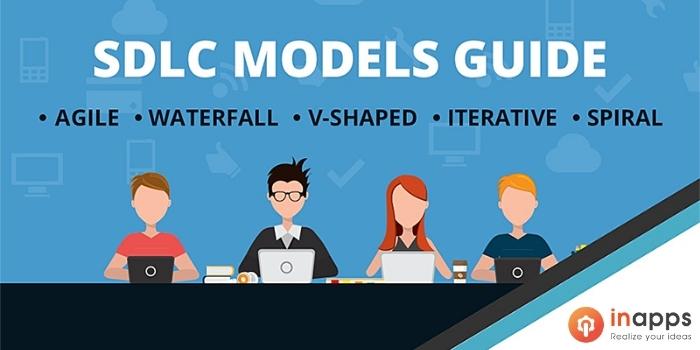
Software development methods
Disadvantages of the Software Development Lifecycle
It reduces cross-departmental communication and collaboration.
Because SDLC is a linear model, and the organization does not move on to the next stage until the current one is completed, this strategy results in information silos.
For example, during the implementation phase, the engineering team is the only team focused on the project. Because they are not all part of a cross-functional team in regular communication throughout the development process, the QA or UX team may lose out on crucial lessons at this period.
It is process-oriented and does not allow for much flexibility.
Another criticism of the SDLC model is that it might cause an organization to become unduly reliant on the process. “People above procedures” is a crucial idea in agile development. This enables an agile team to make fast changes to its strategy as needed.
This is more difficult using the SDLC framework since the team decides to adhere to a particular development plan from the start.
In the early phases, it produces a single point of failure.
The team creates the overall product development strategy based on the initial requirements and analysis. However, if the team does not adequately analyze the market’s demands, this first step might result in a failing product.
In contrast, with an agile strategy, the business regularly examines the progress of its product and solicits regular input from consumers. Consequently, the team is less likely to develop a complete product or important new feature without first determining whether or not there is a market for it. Because of the disadvantages outlined, it may appear that agile development teams would find the SDLC framework useless.
Stages of software development
Each phase generates deliverables needed to carry out the next stage in this software life cycle. The specifications are finally converted into flawless designs. Codes are supplied in line with plans, referred to as the development phase. These phases are created with the assistance of a team of software development technicians responsible for each step. No step is possible without the others.
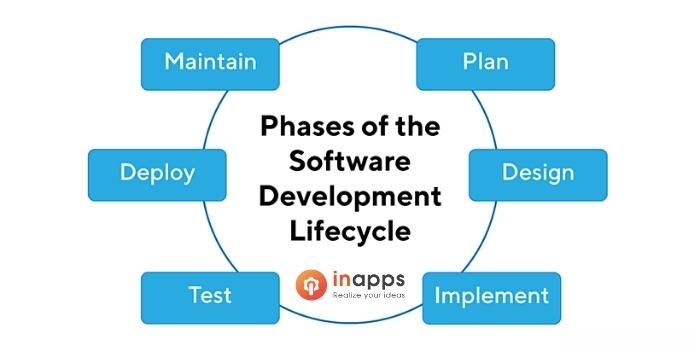
Software Development Phases
Phase 1: Plan
Before the software experts can develop a general idea for any product, the team must first gather and analyze the business requirements. At this phase, the primary emphasis of stakeholders and project managers is to identify the specific features required from any program under consideration. At this point, various questions should be asked, including:
- Who is meant to use this software?
- When the program is finished, how will it be used?
- What kind of data should be included in the software?
- What data should this software produce?
Once these broad problems have been addressed, a rough framework is established for the software developers to work from. This data is then evaluated to guarantee its authenticity and any potential for inclusion. Finally, a requirement specification document is created to guide the next stage of the software process.
Phase 2: Design
This is the next stage in the software development process. The draft design for the program is created in this stage using the stage-1 requirement criteria. System designs aid in the specification of hardware as well as system needs. In software architecture, it also aids in defining an entire system.
The system design specifications are used as input for the next step of the software development methodology. During this phase, the testers build test strategies by describing what to test and how to check it.
Phase 3: Implement/Code
After receiving the design documentation for the program to be built, the work is divided evenly into numerous parts and modules. This is the point at which actual coding begins. The developers’ primary priority during this phase is creating flawless code. This is the longest step of the entire treatment.
Phase 4: Test
If you want to grasp what is software development, you must first comprehend the testing step. This specific step is critical for developers. If something goes wrong during the testing step, or if a mistake is found in the codes, the coding process must be repeated, and the cycle continues until the project is completed.
At this step, all functional testing variations such as integration testing, unit testing, system testing, acceptance testing, and non-functional testing are performed.
Phase 5: Deploy
After removing all code problems during the testing stage, the following stage is known as the deployment stage. The completed code is included in the software and then deployed or provided to users.
As the product is distributed to potential clients, the first step is to conduct beta testing to confirm that it functions correctly on a broad scale. If any modifications or issues are discovered during implementation, the team instantly communicates and fixes the mistakes to operate appropriately in real-time. Once the improvements have been made, and all problems have been resolved, the final dispersion or deployment is initiated.
Phase 6: Maintain
When users begin to use well-developed software, real problems emerge over time. This does not imply that the software will become corrupt. However, issues may arise. This is referred to as maintenance for the finished product or program.
How does the Software Development Process work with Agile sprints?
Besides that, the SDLC framework can and is frequently included in the agile development technique. Agile teams divide the proposed product into tiny software development cycles known as sprints. They will work fast through all of these software development steps with each sprint.
A typical agile sprint lasts two weeks to a month. Each sprint will begin with a sprint planning session for the team. The cross-functional team is now reviewing the backlog. Then they choose a few strategically promising initiatives to focus on and allocate duties to them. They will then concentrate only on those projects and verify their work after the sprint. They will then go to the next sprint.
By breaking up the process, agile businesses may offer new capabilities to the market more rapidly and often. This saves them from waiting for a full product to be built before releasing anything.
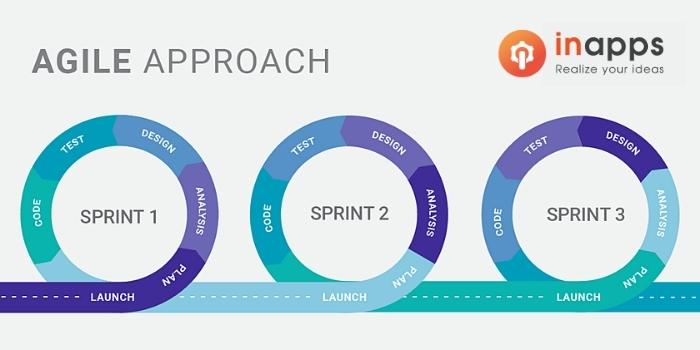
Software development steps
Final Words
We think this is a good starting place to learn more what is software development and the stages of software development. The software development objective is to find predictable and repeatable procedures that increase overall productivity and quality.
Software development is a complex and challenging process. However, with the assistance of software development specialists and a precise software development process, you may have a perfect answer for your firm.
If you need to find a trusted partner for your project, InApps is here to help. Fill in the contact form below to get ONE-TO-ONE consultation.
[sociallocker id=”2721″]
List of Keywords users find our article on Google:
| what is sdlc |
| sdlc framework |
| what is software development life cycle |
| what is software development |
| “it software development and methodology” |
| saas sdlc |
| software development companies |
| standalone 10k |
| are food product development technicians happy |
| mvp maintenance software |
| software development life cycle |
| software development company |
| what is software development lifecycle |
| saas development life cycle |
| software development steps |
| custom software development company |
| custom software development |
| www individual software com |
| sdlc jobs |
| nextstage design |
| lean product & process design |
| agile sprints |
| “software development” |
| makefast uninstaller tool |
| what is software development life cycle model |
| software development firm |
| top software development companies |
| best software development company |
| stages of e commerce sales life cycle |
| lifecycle software |
| saas based product development company |
| customer lifecycle stages |
| what is mvp in agile development |
| contact@sdlc-rcm.net |
| site:www.inapps.net |
| sdlc paradigm |
| neovia logistics jobs |
| sprint agile icon |
| who is accountable for ordering the product backlog answer happy |
| steps in sdlc framework |
| mvp management maintenance software |
| benefits of software development life cycle |
| sdlc 2022 |
| “logical applications for business solutions” |
| icons for software development |
| software development firms |
| lean hardware project management |
| “wawa” |
| sdlc framework steps |
| software development lifecycle |
| the first step in the software development life cycle |
| development life cycle |
| scaling lean and agile development |
| what is sdlc? |
| individual software |
| sdlc full form |
| sdlc full form in computer |
| top software developers |
| the software development life cycle |
| agile development cycle |
| software development life cycle documentation templates |
| what are the steps in software development |
| first step software development |
| how to develop a software step by step |
| top software development company |
| best software development companies |
| distributed agile development |
| software rollout communication plan template |
| waterfall project management tools |
| best software development companies in usa |
| issues in software development |
| best software development strategy |
| how can you gather requirements in software engineering |
| agile software project |
| best software development company usa |
| real estate development software |
| computer software development companies |
| why use agile development |
| agile software development |
| agile software development methods |
| software product development |
| software product development company |
| software development company usa |
| software development company in usa |
[/sociallocker]
Let’s create the next big thing together!
Coming together is a beginning. Keeping together is progress. Working together is success.


















